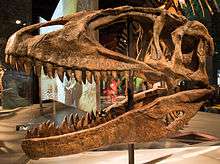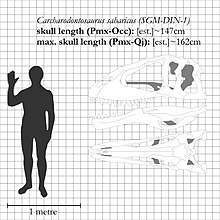Carcharodontosaurus
Carcharodontosaurus /ˌkɑːrkəroʊˌdɒntoʊˈsɔːrəs/ is a genus of carnivorous carcharodontosaurid dinosaurs that existed during the Cenomanian stage of the mid-Cretaceous Period. It is currently known to include two species: C. saharicus and C. iguidensis, which were among the larger theropods, nearly as large as or even larger than Tyrannosaurus, Giganotosaurus and Spinosaurus.
| Carcharodontosaurus | |
|---|---|
 | |
| Reconstructed C. saharicus skull, Science Museum of Minnesota | |
| Scientific classification | |
| Kingdom: | Animalia |
| Phylum: | Chordata |
| Clade: | Dinosauria |
| Clade: | Saurischia |
| Clade: | Theropoda |
| Family: | †Carcharodontosauridae |
| Subfamily: | †Carcharodontosaurinae |
| Genus: | †Carcharodontosaurus Stromer, 1931 |
| Type species | |
| †Carcharodontosaurus saharicus (Depéret & Savornin, 1925) | |
| Species | |
| |
| Synonyms | |
| |
The genus Carcharodontosaurus is named after the shark genus Carcharodon,[1] itself composed of the Greek karchar[os] (κάρχαρος, meaning "jagged" or "sharp") and odōn (ὀδών, "teeth"), and the suffix -saurus ("lizard").
Description

Carcharodontosaurus includes some of the longest and heaviest known carnivorous dinosaurs, with various scientists proposing length estimates for the species C. saharicus ranging between 12 and 13.3 m (39 and 44 ft) and weight estimates between 6.2 and 15.1 metric tons.[2][3][4][5] In 2016 Molina-Pérez & Larramendi gave a length of 12.8 metres and a weight of 7.8 tonnes for C. saharicus, and a length of 11 metres and a weight of 5.2 tonnes for C. iguidensis.[6]
Carcharodontosaurus were carnivores, with enormous jaws and long, serrated teeth up to eight inches long. A skull length of about 1.53—1.6 meters (5.0—5.2 ft) has been restored for C. saharicus,[3][7] and the skull of C. iguidensis is reported to have been about the same size.[8] Currently, the largest-known theropod skull belongs to another huge carcharodontosaurid dinosaur, the closely related Giganotosaurus (with skull length estimates up to 1.95 m) (6.4 ft).[9] Gregory S. Paul estimates Carcharodontosaurus iguidensis at 10 m (33 ft) and 4 t (4.4 short tons).[10]
Brain and inner ear

In 2001, Hans C. E. Larsson published a description of the inner ear and endocranium of Carcharodontosaurus saharicus.[11] Starting from the portion of the brain closest to the tip of the animal's snout is the forebrain, which is followed by the midbrain. The midbrain is angled downwards at a 45-degree angle and towards the rear of the animal. This is followed by the hindbrain, which is roughly parallel to the forebrain and forms a roughly 40-degree angle with the midbrain.[11] Overall, the brain of C. saharicus would have been similar to that of a related dinosaur, Allosaurus fragilis.[11] Larsson found that the ratio of the cerebrum to the volume of the brain overall in Carcharodontosaurus was typical for a non-avian reptile.[11] Carcharodontosaurus also had a large optic nerve.[11]

The three semicircular canals of the inner ear of Carcharodontosaurus saharicus – when viewed from the side – had a subtriangular outline.[11] This subtriangular inner ear configuration is present in Allosaurus, lizards, turtles, but not in birds.[11] The semi-"circular" canals themselves were actually very linear, which explains the pointed silhouette.[11] In life, the floccular lobe of the brain would have projected into the area surrounded by the semicircular canals, just like in other non-avian theropods, birds, and pterosaurs.[11]
Discovery and naming

In 1924, two teeth were found in the Continental intercalaire of Algeria, showing what were at the time unique characteristics. These teeth were described by Depéret and Savornin (1925) as representing a new taxon, which they named Megalosaurus saharicus[12] and later categorized in the subgenus Dryptosaurus.[13] Some years later, paleontologist Ernst Stromer described the remains of a partial skull and skeleton from Cenomanian aged rocks in the Bahariya Formation of Egypt (Stromer, 1931);[1] originally excavated in 1914, the remains consisted of a partial skull, teeth, vertebrae, claw bones and assorted hip and leg bones.[1] The teeth in this new finding matched the characteristics of those described by Depéret and Savornin, which led to Stromer conserving the species name saharicus but finding it necessary to erect a new genus for this species, Carcharodontosaurus, for their strong resemblance to the teeth of Carcharodon (Great white shark).[1]
The fossils described by Stromer were destroyed in 1944 during World War II, but a new, more complete skull was found in the Kem Kem Formation of Morocco during an expedition led by paleontologist Paul Sereno in 1995, near the Algerian border and the locality where the teeth described by Depéret and Savornin (1925) were found. The teeth found with this new skull matched those described by Depéret and Savornin (1925) and Stromer (1931); the rest of the skull also matched that described by Stromer. This new skull was designated as the neotype by Brusatte and Sereno (2007) who also described a second species of Carcharodontosaurus, C. iguidensis from the Echkar Formation of Niger, differing from C. saharicus in aspects of the maxilla and braincase.[8]
Classification

The following cladogram after Apesteguía et al., 2016, shows the placement of Carcharodontosaurus within Carcharodontosauridae.[14]
| ||||||||||||||||||||||||||||||||||||||||||||||||||||||||||
Paleobiology

Hunting
A study by Donald Henderson, the curator of dinosaurs at the Royal Tyrrell Museum suggests that Carcharodontosaurus was able to lift animals weighing a maximum of 424 kg (935 lb) in its jaws based on the strength of its jaws, neck, and its center of mass.[15]
Pathology
SGM-Din 1, a Carcharodontosaurus saharicus skull, has a circular puncture wound in the nasal and "an abnormal projection of bone on the antorbital rim".[16]
References
- Stromer, E. (1931). "Wirbeltiere-Reste der Baharijestufe (unterestes Canoman). Ein Skelett-Rest von Carcharodontosaurus nov. gen." Abhandlungen der Bayerischen Akademie der Wissenschaften, Mathematisch-naturwissenschaftliche Abteilung, 9(Neue Folge): 1–23.
- Holtz, Thomas R. Jr. (2012) Dinosaurs: The Most Complete, Up-to-Date Encyclopedia for Dinosaur Lovers of All Ages, Winter 2011 Appendix.
- Sereno, P. C.; Dutheil, D. B.; Iarochene, M.; Larsson, H. C. E.; Lyon, G. H.; Magwene, P. M.; Sidor, C. A.; Varricchio, D. J.; Wilson, J. A. (1996). "Predatory Dinosaurs from the Sahara and Late Cretaceous Faunal Differentiation". Science. 272 (5264): 986–991. Bibcode:1996Sci...272..986S. doi:10.1126/science.272.5264.986. PMID 8662584.
- Seebacher, F. (2001). "A New Method to Calculate Allometric Length-Mass Relationships of Dinosaurs" (PDF). Journal of Vertebrate Paleontology. 21 (1): 51–60. CiteSeerX 10.1.1.462.255. doi:10.1671/0272-4634(2001)021[0051:ANMTCA]2.0.CO;2. ISSN 0272-4634.
- Therrien, F.; Henderson, D.M. (2007). "My theropod is bigger than yours...or not: estimating body size from skull length in theropods". Journal of Vertebrate Paleontology. 27 (1): 108–115. doi:10.1671/0272-4634(2007)27[108:MTIBTY]2.0.CO;2. ISSN 0272-4634.
- Molina-Pérez & Larramendi (2016). Récords y curiosidades de los dinosaurios Terópodos y otros dinosauromorfos, Larousse. Barcelona, Spain. p. 262.
- Molina-Pérez & Larramendi 2016. Récords y curiosidades de los dinosaurios Terópodos y otros dinosauromorfos, Larousse. Barcelona, Spain p. 142
- Brusatte, S.L. and Sereno, P.C. (2007). "A new species of Carcharodontosaurus (dinosauria: theropoda) from the Cenomanian of Niger and a revision of the genus." Journal of Vertebrate Paleontology, 27(4): .
- Calvo, J.O.; Coria, R.A. (1998). "New specimen of Giganotosaurus carolinii (CORIA & SALGADO, 1995), supports it as the largest theropod ever found" (PDF). Gaia. 15: 117–122. Archived from the original (PDF) on 2008-02-16.
- Paul, G.S., 2010, The Princeton Field Guide to Dinosaurs, Princeton University Press.
- Larsson, H.C.E. 2001. Endocranial anatomy of Carcharodontosaurus saharicus (Theropoda: Allosauroidea) and its implications for theropod brain evolution. pp. 19–33. In: Mesozoic Vertebrate Life. Ed.s Tanke, D. H., Carpenter, K., Skrepnick, M. W. Indiana University Press.
- Deparet, C.; Savornin, J. (1925). "Sur la decouverte d'une faune de vertebres albiens a Timimoun (Sahara occidental)". Comptes Rendus de l'Académie des Sciences de Paris. 181: 1108–1111.
- Deparet, C.; Savornin, J. (1927). "La faune de reptiles et de poisons albiens de Timimoun (Sahara algérien)". Bulletin de la Société Géologique de France. 27: 257–265.
- Sebastián Apesteguía; Nathan D. Smith; Rubén Juárez Valieri; Peter J. Makovicky (2016). "An Unusual New Theropod with a Didactyl Manus from the Upper Cretaceous of Patagonia, Argentina". PLoS ONE. 11 (7): e0157793. Bibcode:2016PLoSO..1157793A. doi:10.1371/journal.pone.0157793. PMC 4943716. PMID 27410683.
- "The Science Behind This Violent Dino Eiffel Tower is Revolutionary".
- "Acrocanthosauridae fam. nov.," in Molnar (2001). Pg. 342.
External links
| Wikimedia Commons has media related to Carcharodontosaurus. |
| Wikispecies has information related to Carcharodontosaurus |



.jpg)
.png)









